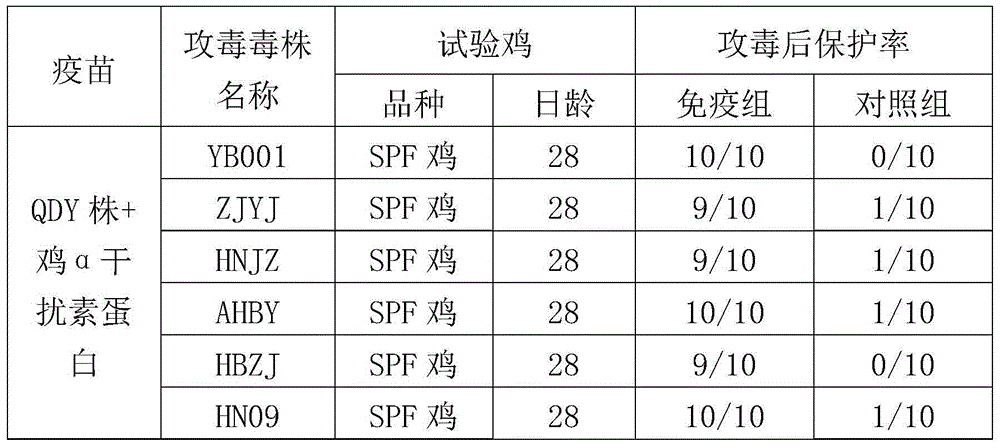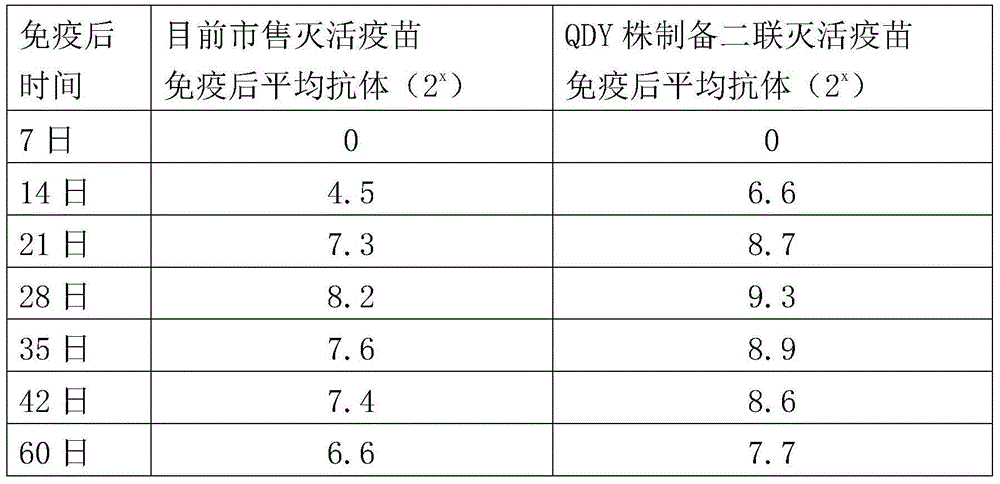New castle disease and H9 subtype bird flu bivalent vaccine
A dual vaccine and Newcastle disease virus technology, which is applied in the field of chicken Newcastle disease and H9 subtype avian influenza dual vaccine, can solve the problems of poor clinical application effect, affecting vaccine prevention and control effect, low antibody level and antibody uniformity, etc., and achieve maintenance The effect of long time, good immunogenicity and small immune dose
- Summary
- Abstract
- Description
- Claims
- Application Information
AI Technical Summary
Problems solved by technology
Method used
Image
Examples
Embodiment 1
[0015] Embodiment 1, the screening of antigenic strain (H9 subtype avian influenza virus QDY strain) for making seedlings
[0016] In 2013, from the infected chickens that had been vaccinated with the H9 subtype avian influenza virus vaccine in Chengyang, Shandong, aseptically collected heart, spleen and other organs, larynx, and cloacal swabs of the affected chickens, and put them in a sterile plate under sterile conditions. After crushing, add physiological saline containing 4000 units / ml double antibody at a ratio of 1:5, and freeze and thaw repeatedly at -20°C for 3 times. Put the cotton swab directly into the physiological saline containing 10,000 units of double antibody, act for 4 hours at 2-8°C, centrifuge the viscera and cotton swab at 3500 rpm for 10 minutes, take the supernatant, mix and inoculate 10-day-old SPF chicken embryo 5 Pieces, 0.2ml / piece. Chicken embryos were incubated at 37°C, inspected once a day in the morning and evening, and the dead embryos were ta...
Embodiment 2
[0020] Embodiment 2: the preparation and inspection of Newcastle disease, avian influenza (H9 subtype) dual inactivated vaccine
[0021] 1. Preparation of Antigen Solution for Seedling Production
[0022] 1.1 Preparation of avian influenza (H9 subtype) antigen solution
[0023] 1.1.1 Propagation of avian influenza (subtype H9) virus Dilute the virus seed (QDY strain) 20,000 times with sterilized normal saline, inoculate 10-11-day-old SPF chicken embryos through the allantoic cavity, 0.2ml per embryo, inoculate Finally, seal the pinholes and continue to incubate at 36-37°C without turning the embryos. The embryos were photographed once a day, and the chicken embryos that died 48 hours ago were discarded. After that, take out the embryos every 4 to 6 hours, and take out the dead chicken embryos at any time until 72 hours, regardless of whether they are dead or not, take them out, and separate the dead chicken embryos from the still alive chicken embryos according to the embryo...
Embodiment 3
[0036] One, the preparation of inactivated vaccine: the semi-finished product antigen after passing the inspection is carried out vaccine preparation (in the following preparation, each liquid component is calculated by volume ratio).
[0037]1. Oil phase preparation Take 95 parts of veterinary white oil and 1 part of aluminum stearate, put it in the oil phase preparation tank and heat it to 80°C, then add 805 parts of Siben-805, and keep it for 30 minutes when the temperature reaches 115°C , and set aside after cooling.
[0038] 2. Preparation of water phase Mix inactivated chicken Newcastle disease virus embryo fluid and H9 subtype avian influenza virus embryo fluid in an appropriate ratio, so that the amount of chicken Newcastle disease virus in each 0.1ml water phase is not less than 10 8.0 EID 50 , H9 subtype avian influenza virus content is not less than 10 7.5 EID 50 . Take 4 parts of sterilized Tween-80, add 96 parts of mixed antigen solution, and stir in the water...
PUM
 Login to View More
Login to View More Abstract
Description
Claims
Application Information
 Login to View More
Login to View More - R&D
- Intellectual Property
- Life Sciences
- Materials
- Tech Scout
- Unparalleled Data Quality
- Higher Quality Content
- 60% Fewer Hallucinations
Browse by: Latest US Patents, China's latest patents, Technical Efficacy Thesaurus, Application Domain, Technology Topic, Popular Technical Reports.
© 2025 PatSnap. All rights reserved.Legal|Privacy policy|Modern Slavery Act Transparency Statement|Sitemap|About US| Contact US: help@patsnap.com



